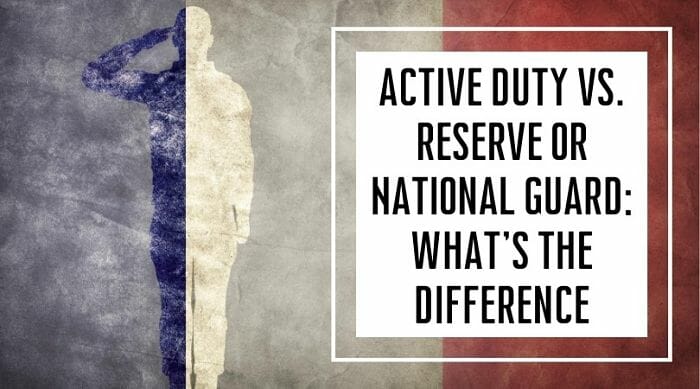ART vs AGR vs TR Jobs In The Guard/Reserve
Updated: July 30, 2021
When deciding to leave active duty, every member must decide their next step. This will include a series of emails and possibly phone calls from in-service recruiters. These recruiters are trying to persuade you to join the National Guard or Reserves. They’ll dazzle you with educational benefits, medical benefits, and even some bonuses.
Once you sound convinced that the Guard or Reserves will help your transition, the recruiter will then try to help find a job at a unit for you. Ultimately, every unit hires its own members, so you will probably have to interview for each position. Before you agree to an interview, do you know what type of job it is? The three common acronyms you will hear are ART, AGR, and TR. To help you decide which is best for you and your family, here’s a brief description of each.
ART (Air Force Reserve Technician)
An ART is an Air Force Reserve Technician. As an ART, you would have dual status. Dual status is when you are considered both a civilian employee and a military member. During the week, you would work a typical 40 hour week for your unit as a federal service employee. You would also have to attend your typical one weekend a month and two weeks a year for Reserve duty. This is when you would be under a military status.
As an ART, you’ll receive a good salary, training and education, the opportunity to travel, and excellent benefits like vacation and sick leave, federal holidays, potential dual retirement annuities, medical, and insurance. There can also be special bonuses that apply just to ART positions.
As an ART, you are a full-time employee working for your unit and a military member of that unit. Keep in mind that you only receive a fraction of credit towards retirement during your civilian and military status. Since you are only required to work a certain number of hours, you only receive retirement credit for those hours, unlike active duty, in which you receive a day for every day you are on active duty status.
AGR (Active Guard/Reserve Position)
An AGR position is an Active Guard/Reserve Position. An AGR position is a full-time military position. An AGR is similar to an ART because they are both full-time jobs. However, they differ because an AGR position places you on active duty orders, making you a full-time active duty member during your tour. As an AGR, you receive all the same benefits as active duty members, including receiving full retirement if you complete your full 20 years of service.
TR (Traditional Reservist)
The final position is the Traditional Reservist (TR) position. This is a Traditional Reservist (or National Guard). The Traditional Reserve/Guard position is what you typically hear about when talking about the reserves. These are the jobs that require you to only serve one weekend a month and two weeks a year. This allows you to have a civilian career while also maintaining a position within the Guard or Reserve. As a TR, you will still receive some benefits and have to maintain training in your career field.
It is a good idea to decide whether you would like to continue to be full-time military or part-time before deciding on a specific unit and job. This will help ensure that the job you are applying for also fits the lifestyle you are trying to achieve. The Veterans Affairs (VA) also has some good resources to help decide the next best step for you and your family. The in-service recruiters are also a good resource for questions on specific jobs and their requirements. Transitioning out of the military back to civilian life has many challenges. Becoming a member of the guard or reserves can help ease this transition. In the end, it’s essential to understand exactly what the required commitment is to the unit so you can make the best decision for yourself and your family.
 Dave Blankenstein served in the US Air Force for 12 years as a C-17 pilot. He was stationed at MacDill AFB, FL, Vance AFB, OK, Joint Base Lewis-McChord, WA, Joint Base Charleston, SC and Altus AFB, OK. Dave attended undergraduate pilot training at Vance, then went to C-17 initial training and ultimately spent the reminder of his time in the military as a C-17 pilot. His military career culminated as a C-17 evaluator at the only C-17 formal training unit in the world. He has a Bachelor’s degree in Aerospace Engineering and a master’s degree in Aeronautical Science with a concentration in Aviation Safety Science.
Dave Blankenstein served in the US Air Force for 12 years as a C-17 pilot. He was stationed at MacDill AFB, FL, Vance AFB, OK, Joint Base Lewis-McChord, WA, Joint Base Charleston, SC and Altus AFB, OK. Dave attended undergraduate pilot training at Vance, then went to C-17 initial training and ultimately spent the reminder of his time in the military as a C-17 pilot. His military career culminated as a C-17 evaluator at the only C-17 formal training unit in the world. He has a Bachelor’s degree in Aerospace Engineering and a master’s degree in Aeronautical Science with a concentration in Aviation Safety Science.
Most Popular Military Careers Articles

FBI Agent vs. CIA Officer: What’s the Difference?

Space Force Careers

How to Become a Military Doctor































































